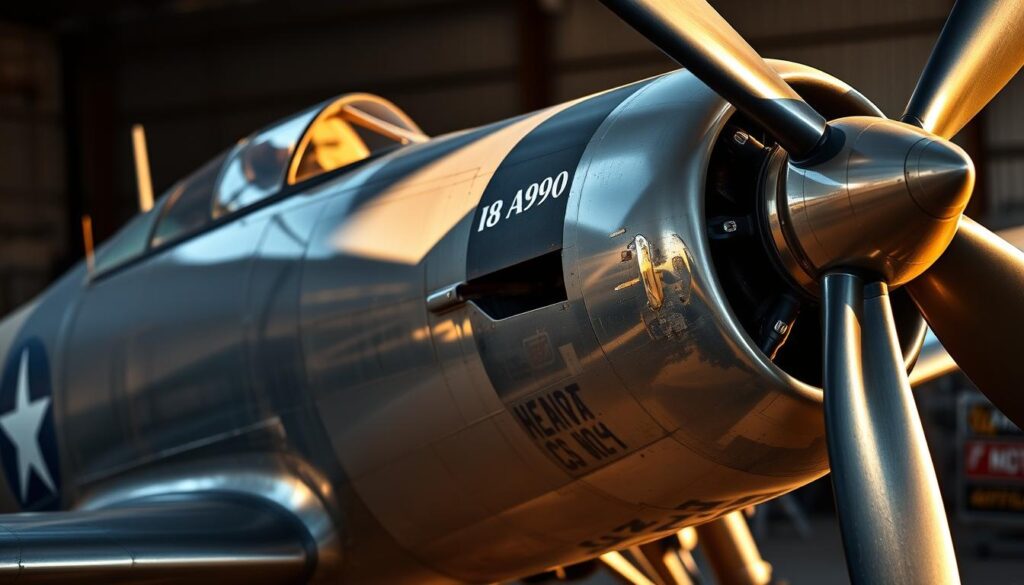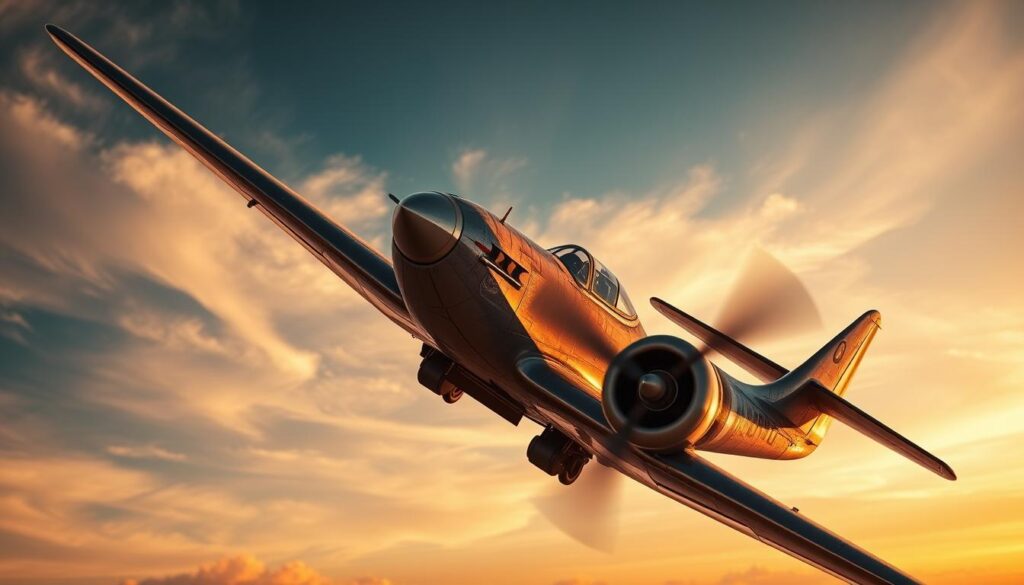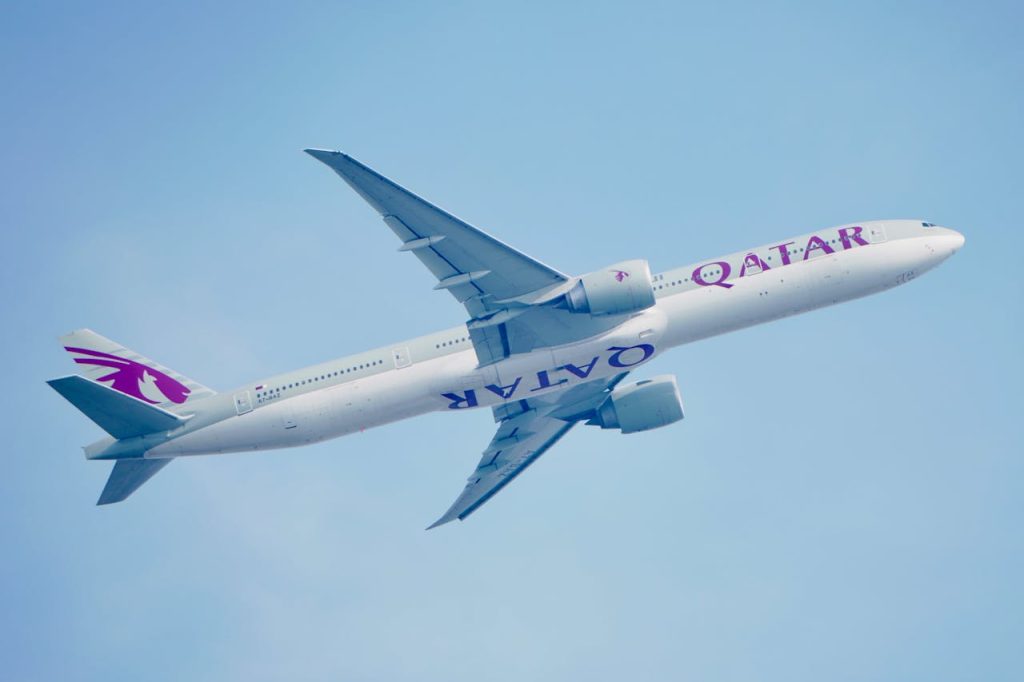We’re about to dive into a piece of aviation history – the 1944 North American SNJ5, with the registration number N15090. This vintage aircraft is a rare find. It’s been kept in great shape thanks to careful maintenance.
Since 1958, this plane has been in the hands of one family. It’s not just a piece of history. It shows the hard work and love of its owners. As we explore its story, specs, and value, we’ll learn about warbird restoration.
Key Takeaways
- The 1944 North American SNJ5 (N15090) is a rare, well-preserved warbird.
- It has been owned by one family since 1958.
- The aircraft is a significant piece of aviation history.
- Warbird restoration is a meticulous process.
- The aircraft’s current market value is of interest to collectors.
Overview of the North American SNJ5
The North American SNJ5 is a key aircraft in aviation history. It played a big role in military training during World War II. It helped prepare pilots for combat missions.
Historical Context and Significance
The SNJ5 was made during a time when military aviation was changing fast. Its design and features made it perfect for training pilots. It helped the war effort by giving high-quality training to many pilots.
The aircraft’s durability and maneuverability were key to its success. It let pilots practice in a safe way before flying combat planes.
Production Numbers and Variants
The North American SNJ5 was made in large numbers, with many variants. Over 15,000 aircraft were produced, making it a top trainer of its time.
| Variant | Production Numbers | Notable Features |
|---|---|---|
| SNJ-3 | 1,500 | Initial production model with Pratt & Whitney R-1340 engine |
| SNJ-4 | 2,000 | Improved version with minor design changes |
| SNJ-5 | 4,000 | Most produced variant, known for its reliability and performance |
Key Features and Specifications
The SNJ5 had a Pratt & Whitney R-1340 radial engine. This gave it reliable performance and ease of maintenance. It had a strong airframe, great visibility, and the right instruments for training.
- Length: 29 feet 9 inches
- Wingspan: 37 feet 0 inches
- Height: 11 feet 9 inches
- Cruise Speed: 143 mph
The Role of SNJ5 in Military Training
The SNJ5 was a key part of military flight training. Its design and performance made it perfect for training pilots. It helped them get ready for more advanced planes.
Transition to Jet Training
The SNJ5 was crucial in helping pilots move from propeller planes to jets. Its features and handling made it a great bridge between these two types of planes.
Key features that helped with this transition included:
- Robust airframe capable of withstanding high-G forces
- Powerful engine that provided a realistic simulation of jet aircraft performance
- Advanced avionics for its time, including navigation and communication equipment
Aviation historians say the SNJ5 was key in preparing pilots for jets. It helped close the training gap and made flying safer.
“The SNJ5’s versatility and performance made it an invaluable asset in military pilot training programs, paving the way for the next generation of fighter pilots.”
Impact on Pilot Training Techniques
The SNJ5 changed pilot training by offering a more complete training program. It let instructors practice a wide range of scenarios. This included basic flight skills and complex combat training.
The benefits of using the SNJ5 for pilot training included:
- Enhanced situational awareness through realistic flight simulations
- Improved handling skills due to the aircraft’s responsive controls
- Increased confidence among pilots transitioning to more advanced aircraft
Notable Training Squadrons
Many notable training squadrons used the SNJ5 as their main trainer. These squadrons were key in shaping military pilots’ skills.
Some of the most famous training squadrons that used the SNJ5 were:
- The US Navy’s Training Squadron
- The US Air Force’s Pilot Training Command
- Various Marine Corps training units
The SNJ5’s role in military training is still celebrated today. Aviation collectors and enthusiasts honor its role in military aviation’s growth.
Design and Engineering of the SNJ5
The North American SNJ5 is known for its top-notch engineering and toughness. It was a key trainer aircraft during World War II. Its strong airframe and dependable engine made it perfect for teaching pilots.
Airframe and Structural Innovations
The SNJ5’s airframe was built to last, with a sturdy structure for training. Its low-wing design helped with stability and handling. The use of new materials and techniques at the time ensured its strength and long life.
Engine and Performance Specs
The SNJ5 uses a Pratt & Whitney R-1340-AN-1 engine, known for its reliability and power. It also has a Hamilton Standard 2D40-225 propeller, famous for its efficiency and durability.
| Specification | Detail |
|---|---|
| Engine | Pratt & Whitney R-1340-AN-1 |
| Propeller | Hamilton Standard 2D40-225 |
| Performance | Reliable radial engine performance |
Avionics and Instrumentation
The SNJ5 had advanced avionics and instruments for its era. These tools helped pilots navigate and communicate. The cockpit had many instruments to mimic real flight conditions.
The SNJ5’s design and engineering made it a reliable trainer. It played a big role in aviation history. Today, it’s still celebrated by aviation fans and historians.
Iconic Appearance and Aesthetic Appeal
The North American SNJ5 is famous for its eye-catching look. It has won the hearts of many who love airplanes. Its unique design is why it’s so popular among collectors and history buffs.
Color Schemes and Markings
The SNJ5, like N15090, sports U.S. Navy Instrument Training markings. This makes it stand out and honors its military past. The colors and markings tell a story of its role in WWII training.
Interior Design Features
The SNJ5’s interior is a highlight. It’s kept or restored to its original state. This shows off its practical design and the skill of its makers.
Comparison with Other WWII Trainers
The SNJ5 is unique among WWII trainers. It’s known for its strong build, beauty, and historical importance. Here’s how it compares to others:
| Aircraft | Color Scheme | Interior Features | Historical Significance |
|---|---|---|---|
| SNJ5 | U.S. Navy Instrument Training | Original Interior | Prominent in Naval Training |
| AT-6 | Varied, including USAAF markings | Functional, some restored to original | Extensive use in pilot training |
| BT-13 | USAAF Yellow, some with training markings | Basic, focused on functionality | Large numbers produced for training |
The SNJ5’s beauty, history, and condition make it special. It’s loved by those who admire aircraft and collect them.
The Legacy of the North American SNJ5
The SNJ5 still excites aviation fans all over the world. It has made a big mark on aviation history. Its impact can be seen in today’s military training planes.
Contributions to Aviation History
The SNJ5 was key in shaping military flying and training methods. Its strong build and flexibility made it perfect for training during World War II and later. It helped shape future trainers and prepared pilots for battle.
“The SNJ5 has been preserved and restored by collectors and museums, ensuring its legacy for future generations.” –
The SNJ5’s impact goes beyond its use in the military. It’s also a key piece in military aviation history. Many are kept in museums for all to see.
Notable Aircraft in Museums
Many SNJ5s are on display in museums worldwide. They show its importance in history. Here are a few notable ones:
- The National Museum of Naval Aviation in Pensacola, Florida
- The National WWII Museum in New Orleans, Louisiana
- The Museum of Aviation at Robins Air Force Base in Warner Robins, Georgia
| Museum | Location | Exhibit Details |
|---|---|---|
| National Museum of Naval Aviation | Pensacola, Florida | SNJ5 on display with historical markings |
| National WWII Museum | New Orleans, Louisiana | SNJ5 featured in a World War II trainer aircraft exhibit |
| Museum of Aviation | Warner Robins, Georgia | Restored SNJ5 showcasing its combat training role |
Modern-Day Restorations and Collectors
The SNJ5 is still loved by collectors and restorers today. They work hard to bring these planes back to their original state. Their efforts keep the SNJ5 flying and on display at airshows.
Warbird restoration is a growing field, with the SNJ5 being a top choice. These efforts not only preserve the planes but also keep their stories alive.
N15090 – A Closer Look
Exploring N15090 reveals the hard work and love put into restoring this legendary warbird. The SNJ5 aircraft, known as N15090, showcases the skill of aircraft restoration. It also highlights the support from the aviation community.
Restoration Journey of N15090
The restoration of N15090 is a tale of careful attention and detail. With 8202.1 hours logged and 128.3 hours since its major overhaul, it’s ready to fly. The team aimed to restore it to its original state while also meeting today’s safety standards.
Restorers and maintainers have worked hard to keep N15090’s history intact while making it safe to fly. They’ve searched for original parts, inspected everything carefully, and tested it thoroughly. This ensures the aircraft is ready for the skies.
Flight Performance and Capabilities
N15090’s flight abilities showcase the SNJ5’s design and engineering. It’s known for its quickness and ease of handling, loved by pilots who’ve flown it.
The SNJ5’s role as a trainer aircraft during World War II is evident in its performance. Its agility made it perfect for teaching pilots essential skills.
| Specification | Value |
|---|---|
| Airframe Hours | 8202.1 |
| Engine Hours Since Overhaul | 128.3 |
Community Contributions and Events
The community around N15090 is lively and dedicated, with many helping to preserve it. Aviation events and airshows let people see N15090 up close. They appreciate its historical value.
Support for N15090 comes in many forms, from donations to hands-on work. Events like airshows and fly-ins not only showcase N15090 but also help fund its upkeep and other restoration projects.

Thanks to the community and the restorers, N15090 keeps flying. It’s a living piece of aviation history. Its story reminds us of the need to preserve our aviation heritage for the future.
Availability and Market Value
Knowing the market for the SNJ5 is key for collectors and fans. The SNJ5, a part of the North American T-6 Texan family, is loved by many. It has a special place in the hearts of warbird enthusiasts and collectors.
Current Listings for SNJ5 Models
Right now, you can find several SNJ5 models for sale online. For example, the SNJ5 (N15090) is up for $215,000 on Platinum Fighter Sales. Prices can change based on the aircraft’s state, restoration, and history.
“The market for vintage planes like the SNJ5 is strong,” says a top warbird restoration expert. “It’s driven by collectors and fans who love history and authenticity.”
Factors Affecting Value
Several things affect an SNJ5’s market value:
- Condition and Originality: Planes in their original state or well-restored are highly sought after.
- Historical Significance: SNJ5s with interesting histories, like being in a famous squadron, sell for more.
- Maintenance and Airworthiness: The plane’s airworthiness and maintenance records are key to its value.
Investment Potential for Collectors
The SNJ5 is a good investment for collectors because of its history and the growing interest in warbird restoration. As James E. Farmer, a well-known aviation historian, says, “The T-6/SNJ series, including the SNJ5, has seen its value go up over time. It’s a great choice for collectors.”
Investing in an SNJ5 needs a good understanding of the market and what affects its value. With the right knowledge, collectors can make smart choices. They can not only keep aviation history alive but also make a good investment.
Enthusiast Communities and Clubs
The SNJ5 has a big following among aircraft enthusiasts. Many communities and clubs work to keep its legacy alive. They are key in preserving this iconic aircraft.
Online Forums and Resources
Online forums are essential for warbird restoration fans. They share knowledge, resources, and stories. Websites and social media groups for the SNJ5 are great for discussing restoration and sharing photos.

Local Chapters and Events
Local aviation clubs and organizations also play a big role. They host events, airshows, and meetings. These gatherings let enthusiasts network, see SNJ5s up close, and talk about restoration.
Collaborative Restoration Projects
Collaborative restoration projects are a highlight of the SNJ5 community. Enthusiasts work together, using their skills and resources. These projects keep the aircraft in top shape and build friendships.
Joining these communities is a great way to learn from experts. Together, they keep the SNJ5’s legacy alive.
Safety Features and Maintenance
The SNJ5 aircraft needs careful maintenance to stay safe and airworthy. Being a historic plane, the SNJ5 (N15090) requires regular checks and repairs. This keeps it flying well.
Regular Maintenance Practices
Keeping the SNJ5 in top shape is key. This means checking the engine, airframe, and avionics often. For example, the SNJ5 (N15090) needs an inspection at Hobbs 602.3, as Platinum Fighter Sales notes.
Important maintenance steps include:
- Daily checks for wear or damage
- Engine checks for best performance
- Avionics system checks for communication and navigation
Safety Enhancements over Time
The SNJ5 has seen many safety upgrades over the years. These changes have kept the plane safe and airworthy, protecting pilots.
| Safety Enhancement | Description | Year Implemented |
|---|---|---|
| Improved Engine Mounts | Enhanced durability and reduced vibration | 1950s |
| Advanced Avionics | Upgraded navigation and communication systems | 1960s |
| Structural Reinforcements | Strengthened airframe to withstand flight stresses | 1970s |
Training for Maintenance Personnel
Training maintenance staff is crucial for the SNJ5’s upkeep. This training covers both theory and hands-on skills, tailored to the SNJ5’s needs.
Key training points include:
- Learning the SNJ5’s history and special features
- Knowing the aircraft’s systems and parts
- Getting practical experience in maintenance and repairs
By focusing on safety and maintenance, we see the effort needed to keep these historic planes flying.
Exploring the Future of Vintage Trainers
The world of vintage aviation is still exciting many people today. There’s a big push to keep historic planes like the North American SNJ5 flying. This effort is making sure these iconic aircraft are preserved for the future.
Current Trends
There’s a big comeback in vintage aviation. People are now more interested in the planes that helped shape the industry. This interest is leading to a focus on keeping restorations true to their original form.
Preserving the Past
Keeping vintage trainers in good shape is very important. Groups and individuals are working hard to restore these planes. They want to make sure future generations can see and learn from these historic aircraft.
Relevance in Modern Training
Even today, vintage trainers like the SNJ5 are still important in flight training. They offer insights into how pilot training has evolved over time. This knowledge helps in making modern flight training better.
By honoring our aviation history, we can learn from the past. This learning helps shape the future of flight training.


